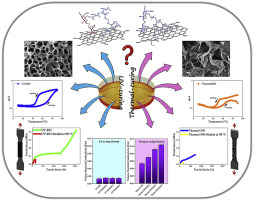Polymer ( IF 4.1 ) Pub Date : 2019-12-30 , DOI: 10.1016/j.polymer.2019.122138 Sara Tarashi , Hossein Nazockdast , Gholamhossein Sodeifian

|
Physical-chemical double network (DN) hydrogels have been well recognized as new tough materials with unique structural platforms demonstrating a collection of various properties including superior mechanical strength, remarkable toughness recovery and self-healing property into a single material. However, a comprehensive study on the effect of synthesis methods of DN hydrogels is very critical as they influence their properties and performances. This study is aimed at investigating the effect of two different synthesis methods of thermal-curing and UV-curing on microstructure and physical-mechanical properties including self-healing capability, swelling and water-retaining capacity, as well as electrical conductivity of the κ-carrageenan (κ-Car)/polyacrylamide (PAm) DN hydrogel. Compared to the thermal-cured DN hydrogel, the UV-cured DN hydrogel has exhibited different mechanical behavior (plastic-like with localized necking vs. elastomeric-like), excellent mechanical properties (failure stress = 0.42 MPa vs. 0.12 MPa, failure strain = 2079%, vs. 722%, elastic modulus = 0.1 MPa vs. 0.069 MPa, and fracture energy = 3.54 MJ/m3 vs. 0.50 MJ/m3), and much greater self-healing capability. These could be explained in terms of reducing the contribution of the κ-Car physical network and also reversible interactions in the favor of increasing the cross-link density of PAm chemical network as a consequence of grafting reaction in the thermally-cured hydrogel, although the non-uniform lamellar-like structure in thermally-cured hydrogel could also play a role. By focusing on the linear and nonlinear rheological measurements, it was also demonstrated that the UV-curing method has resulted in much better thermo-reversibility of the hydrogel as a valuable property that can significantly extend the application of the κ-Car/PAm DN hydrogels. An attempt was also made to explore the effect of synthesis methods on the microstructure and physical-mechanical performance of the k-Car/PAm DN hydrogels in presence of GO nanosheets. In both synthesis methods, the presence of GO was found to have an enhancing effect on the properties of DN hydrogels. In the case of thermally-cured hydrogels, a partial reduction of GO was occurred which could, in turn, affect the performance of the hydrogels. It is hoped that this knowledge can contribute to a better understanding of the correlation between microstructure and different properties of hydrogels to precisely design a structural DN hydrogel with a special performance for the desired applications.
中文翻译:

基于κ-car/ PAm / GO的两种不同合成的纳米复合双网络水凝胶的微观结构,物理力学性能和自愈性能的比较研究
物理化学双网络(DN)水凝胶已被公认为具有独特结构平台的新型坚韧材料,展示了多种特性的集合,包括优异的机械强度,显着的韧性恢复性和自愈特性。然而,对DN水凝胶合成方法效果的全面研究非常关键,因为它们会影响其性能和性能。这项研究旨在研究热固化和紫外线固化两种不同合成方法对微观结构和物理机械性能的影响,包括自我修复能力,溶胀和保水能力以及κ-淀粉的电导率。角叉菜胶(κ-Car)/聚丙烯酰胺(PAm)DN水凝胶。与热固化DN水凝胶相比,3比0.50 MJ / m 3),以及更大的自我修复能力。这些可以通过减少κ-Car物理网络的贡献以及可逆相互作用来解释,这是由于热固化水凝胶中的接枝反应而增加了PAm化学网络的交联密度,尽管热固化水凝胶中不均匀的层状结构也可能起一定作用。通过关注线性和非线性流变学测量,还证明了紫外线固化方法已使水凝胶具有更好的热可逆性,这是一种有价值的特性,可以显着扩展κ-Car/ PAm DN水凝胶的应用。还尝试探索合成方法对存在GO纳米片的k-Car / PAm DN水凝胶的微观结构和物理机械性能的影响。在两种合成方法中,都发现GO的存在对DN水凝胶的性能具有增强作用。在热固化的水凝胶的情况下,GO发生了部分还原,这反过来又会影响水凝胶的性能。希望这些知识可以有助于更好地理解水凝胶的微观结构与不同性质之间的相关性,从而为所需应用精确设计具有特殊性能的结构DN水凝胶。在热固化的水凝胶的情况下,GO发生了部分还原,这反过来又会影响水凝胶的性能。希望这些知识可以有助于更好地理解水凝胶的微观结构与不同性质之间的相关性,从而为所需应用精确设计具有特殊性能的结构DN水凝胶。在热固化的水凝胶的情况下,GO发生了部分还原,这反过来又会影响水凝胶的性能。希望这些知识可以有助于更好地理解水凝胶的微观结构与不同性质之间的相关性,从而为所需应用精确设计具有特殊性能的结构DN水凝胶。











































 京公网安备 11010802027423号
京公网安备 11010802027423号